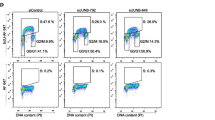Summary
Transformed JB6 cells can be stably reverted to nontransformed phenotype by AP-1 inhibiting glucocorticoid fluocinolone (FA) and cAMP elevator forskolin (FN), yielding stable revertants of promotion resistant (P−) and promotion sensitive (P+) phenotypes. AP-1 activity of nontransformed P− and P+ revertant clones was decreased under a variety of experimental conditions compared with their transformed counterparts. Moreover, AP-1 activity in P+ cells under anchorage-independent conditions was induced by 12-0-tetradecanoyl-phorbol-13-acetate (TPA) while AP-1 activity in the reverted P− cells was not induced, just as observed for the original P+ and P− variants. Taken together these data suggest that changes in AP-1 activity may be one key mediator not only of forward progression but also of reversion of tumor cells to nontransformed phenotype. In addition, the higher transfection efficiency of the new reverted P− and P+ cells renders them useful for studying the role of transcription factors in tumor promotion.
Similar content being viewed by others
References
Bernstein, L. R.; Colburn, N. H. AP1/jun function is differentially induced in promotion-sensitive and resistant JB6 cells. Science 244: 566–569; 1989.
Colburn, N. H.; Former, B. F.; Nelson, K. A., et al. Tumor promoter induces anchorage independence irreversibly. Nature (Lond.) 281: 589–591; 1979.
Colburn, N. H.; Gindhart, T. Specific binding of transforming growth factor correlates with promotion of anchorage independence in EGF receptorless JB6 cells. Biochem. Biophys. Res. Commun. 102:799–807; 1981.
Colburn, N. H.; Vorder Bruegge, W. F.; Bates, J. R., et al. Correlation of anchorage independent growth with tumorigenicity of chemically transformed mouse epidermal cells. Cancer Res. 38:624–634; 1978.
Dong, Z.; Birrer, M. J.; Watts, R. G., et al. Blocking tumor promoter induced AP-1 activity inhibits induced transformation in JB6 cells. Proc. Natl. Acad. Sci. USA 91:609–613; 1993.
Dong, Z.; Lavrovsky, V. A.; Colburn, N. H. Induction of reverse transformation in JB6 RT101 cells by AP-1 inhibitors. Carcinogenesis 16:749–756; 1995.
Kitayama, H.; Sugimoto, Y.; Matsuzaki, T., et al. A ras-related gene with transformation suppressor activity. Cell 56:77–84; 1989.
Kolch, W.; Heidecker, G.; Troppmair, J., et al. Raf revertant cells resist transformation by non-nuclear oncogenes and are deficient in the induction of response genes by TPA and serum. Oncogene 8:361–370; 1993.
Krzyzosiak, W. J.; Shindo-Okada, N.; Teshima, H., et al. Isolation of genes specifically expressed in flat revertant cells derived from activated ras-transformed NIH 3T3 cells by treatment with azatyrosine. Proc. Natl. Acad. Sci. USA 89:4879–4883; 1992.
Lavrovsky, V. A.; Guvakova, M. A.; Lavrovsky, J. V. High frequency of tumor cell reversion to non-tumorigenic phenotype. Eur. J. Cancer 28:17–21; 1992.
Lea, M. A. Action of exogenous differentiating agents on genes expression in cancer cells. Crit. Rev. Oncol. Hematol. 13:189–214; 1992.
Noda, M. Mechanisms of reversion. FASEB J. 7:834–840; 1993.
Takahashi, K.; Heine, U. I.; Junker, J. L., et al. Role of cytoskeleton changes and expression of the H-ras oncogene during promotion of neoplastic transformation in mouse epidermal JB6 cells. Cancer Res. 46:5923–5932; 1986.
Tanaka, K.; Yanoshita, R.; Konishi, M., et al. Suppression of tumorigenicity in human colon carcinoma cells by introduction of normal chromosome 1p36 region. Oncogene 8:2253–2258; 1993.
Wisdom, R.; Verma, I. M. Revertants of V-fos-transformed rat fibroblasts: suppression of transformation is dominant. Mol. Cell. Biol. 10:5626–5633; 1990.
Author information
Authors and Affiliations
Rights and permissions
About this article
Cite this article
Lavrovsky, V., Dong, Z., Ma, W.Y. et al. Drug-induced reversion of progression phenotype is accompanied by reversion of AP-1 phenotype in JB6 cells. In Vitro Cell.Dev.Biol.-Animal 32, 234–237 (1996). https://doi.org/10.1007/BF02722951
Received:
Accepted:
Issue Date:
DOI: https://doi.org/10.1007/BF02722951




